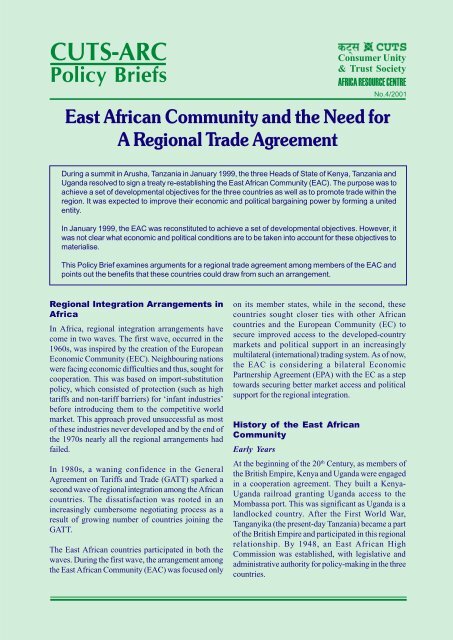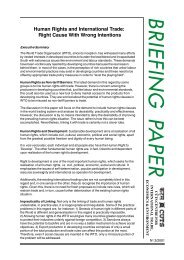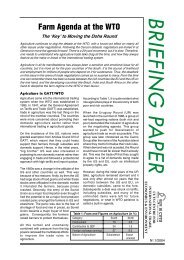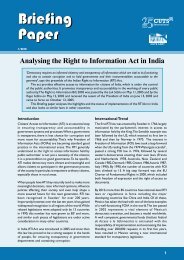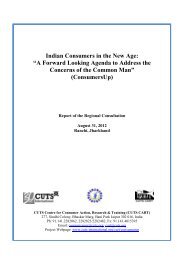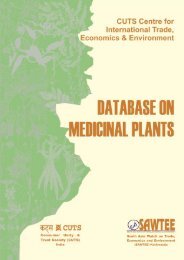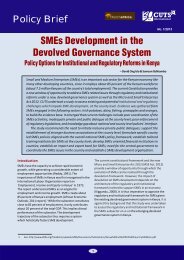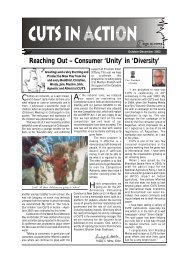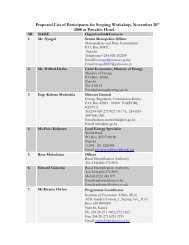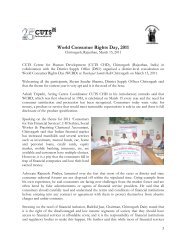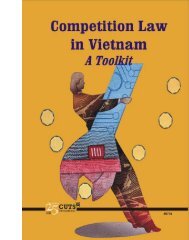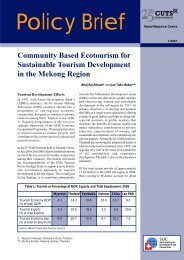East African Community and the Need for A Regional Trade ...
East African Community and the Need for A Regional Trade ...
East African Community and the Need for A Regional Trade ...
You also want an ePaper? Increase the reach of your titles
YUMPU automatically turns print PDFs into web optimized ePapers that Google loves.
CUTS-ARCPolicy BriefsConsumer Unity& Trust SocietyAFRICA RESOURCE CENTRENo.4/2001<strong>East</strong> <strong>African</strong> <strong>Community</strong> <strong>and</strong> <strong>the</strong> <strong>Need</strong> <strong>for</strong>A <strong>Regional</strong> <strong>Trade</strong> AgreementDuring a summit in Arusha, Tanzania in January 1999, <strong>the</strong> three Heads of State of Kenya, Tanzania <strong>and</strong>Ug<strong>and</strong>a resolved to sign a treaty re-establishing <strong>the</strong> <strong>East</strong> <strong>African</strong> <strong>Community</strong> (EAC). The purpose was toachieve a set of developmental objectives <strong>for</strong> <strong>the</strong> three countries as well as to promote trade within <strong>the</strong>region. It was expected to improve <strong>the</strong>ir economic <strong>and</strong> political bargaining power by <strong>for</strong>ming a unitedentity.In January 1999, <strong>the</strong> EAC was reconstituted to achieve a set of developmental objectives. However, itwas not clear what economic <strong>and</strong> political conditions are to be taken into account <strong>for</strong> <strong>the</strong>se objectives tomaterialise.This Policy Brief examines arguments <strong>for</strong> a regional trade agreement among members of <strong>the</strong> EAC <strong>and</strong>points out <strong>the</strong> benefits that <strong>the</strong>se countries could draw from such an arrangement.<strong>Regional</strong> Integration Arrangements inAfricaIn Africa, regional integration arrangements havecome in two waves. The first wave, occurred in <strong>the</strong>1960s, was inspired by <strong>the</strong> creation of <strong>the</strong> EuropeanEconomic <strong>Community</strong> (EEC). Neighbouring nationswere facing economic difficulties <strong>and</strong> thus, sought <strong>for</strong>cooperation. This was based on import-substitutionpolicy, which consisted of protection (such as hightariffs <strong>and</strong> non-tariff barriers) <strong>for</strong> ‘infant industries’be<strong>for</strong>e introducing <strong>the</strong>m to <strong>the</strong> competitive worldmarket. This approach proved unsuccessful as mostof <strong>the</strong>se industries never developed <strong>and</strong> by <strong>the</strong> end of<strong>the</strong> 1970s nearly all <strong>the</strong> regional arrangements hadfailed.In 1980s, a waning confidence in <strong>the</strong> GeneralAgreement on Tariffs <strong>and</strong> <strong>Trade</strong> (GATT) sparked asecond wave of regional integration among <strong>the</strong> <strong>African</strong>countries. The dissatisfaction was rooted in anincreasingly cumbersome negotiating process as aresult of growing number of countries joining <strong>the</strong>GATT.The <strong>East</strong> <strong>African</strong> countries participated in both <strong>the</strong>waves. During <strong>the</strong> first wave, <strong>the</strong> arrangement among<strong>the</strong> <strong>East</strong> <strong>African</strong> <strong>Community</strong> (EAC) was focused onlyon its member states, while in <strong>the</strong> second, <strong>the</strong>secountries sought closer ties with o<strong>the</strong>r <strong>African</strong>countries <strong>and</strong> <strong>the</strong> European <strong>Community</strong> (EC) tosecure improved access to <strong>the</strong> developed-countrymarkets <strong>and</strong> political support in an increasinglymultilateral (international) trading system. As of now,<strong>the</strong> EAC is considering a bilateral EconomicPartnership Agreement (EPA) with <strong>the</strong> EC as a steptowards securing better market access <strong>and</strong> politicalsupport <strong>for</strong> <strong>the</strong> regional integration.History of <strong>the</strong> <strong>East</strong> <strong>African</strong><strong>Community</strong>Early YearsAt <strong>the</strong> beginning of <strong>the</strong> 20 th Century, as members of<strong>the</strong> British Empire, Kenya <strong>and</strong> Ug<strong>and</strong>a were engagedin a cooperation agreement. They built a Kenya-Ug<strong>and</strong>a railroad granting Ug<strong>and</strong>a access to <strong>the</strong>Mombassa port. This was significant as Ug<strong>and</strong>a is al<strong>and</strong>locked country. After <strong>the</strong> First World War,Tanganyika (<strong>the</strong> present-day Tanzania) became a partof <strong>the</strong> British Empire <strong>and</strong> participated in this regionalrelationship. By 1948, an <strong>East</strong> <strong>African</strong> HighCommission was established, with legislative <strong>and</strong>administrative authority <strong>for</strong> policy-making in <strong>the</strong> threecountries.
In 1961, as <strong>the</strong> countries were on <strong>the</strong> verge ofindependence from <strong>the</strong> British rule, <strong>the</strong> <strong>East</strong> <strong>African</strong>Common Service Organisation replaced <strong>the</strong> <strong>East</strong><strong>African</strong> High Commission established by <strong>the</strong> British.The <strong>East</strong> <strong>African</strong> <strong>Community</strong> was established in 1967with <strong>the</strong> goal of <strong>for</strong>ming <strong>the</strong> <strong>East</strong> <strong>African</strong> CommonMarket.The main objectives of <strong>the</strong> <strong>Community</strong> were tostreng<strong>the</strong>n <strong>and</strong> regulate industrial, commercial <strong>and</strong>o<strong>the</strong>r relationships to <strong>the</strong> end that <strong>the</strong>re shall beaccelerated, harmonious <strong>and</strong> balanced development<strong>and</strong> sustained expansion of economic activities.The accrued benefits were expected to be sharedequitably through harmonisation of economic policy,<strong>for</strong>mulation of joint projects <strong>and</strong> consultation during<strong>the</strong> planning stage, <strong>and</strong> implementation in areas suchas agriculture, education <strong>and</strong> manpower, energy <strong>and</strong>power, industry, tourism, balance of payments,transport <strong>and</strong> communications, etc.In <strong>the</strong> first half of <strong>the</strong> 1970s, Kenya embracedcapitalism, Tanzania socialism, <strong>and</strong> Ug<strong>and</strong>a wasconfronted with a political coup, which put a questionmark on <strong>the</strong> political stability of <strong>the</strong> region. Ultimately,ideological division among <strong>the</strong> members, coupled withUg<strong>and</strong>a <strong>and</strong> Tanzania’s frustration over increasingtrade deficit with Kenya, were two significant factorsleading to <strong>the</strong> demise of <strong>the</strong> EAC in 1977, a decadeafter its inception.The EAC could not attain its goal of establishing amonetary union because <strong>the</strong> <strong>East</strong> <strong>African</strong> CurrencyBoard (EACB) disb<strong>and</strong>ed into three separate centralbanks. The economic foundations of <strong>the</strong> arrangementwere shaken fur<strong>the</strong>r when ano<strong>the</strong>r essential organcould not meet its objectives.The <strong>East</strong> <strong>African</strong> Development Bank (EADB) wasintended to develop <strong>the</strong> region’s industries by takingequal amount of contributions from <strong>the</strong> three memberstates<strong>and</strong> in turn investing 38.75 percent each inTanzania <strong>and</strong> Ug<strong>and</strong>a, <strong>and</strong> 22.5 percent in Kenya.However, as <strong>the</strong> EADB was to invest in ‘viable’projects only, which were mostly in Kenya, itexperienced difficulties in meeting its developmentalaims <strong>for</strong> <strong>the</strong> region as a whole.The New IncarnationIn 1984, ef<strong>for</strong>ts were made <strong>for</strong> making a regionaltrade agreement among <strong>the</strong> EAC member states. In1993, in order to increase <strong>the</strong> level of cooperation <strong>the</strong>three countries established a Tripartite Commission<strong>for</strong> <strong>East</strong> <strong>African</strong> Cooperation, which began itsoperation in March 1996. In 1998, <strong>the</strong>se countriesdecided that a political federation with zero internaltariff on <strong>the</strong> majority of goods <strong>and</strong> with a singlecommon external tariff would be <strong>the</strong> ultimate objectiveof <strong>the</strong> new <strong>East</strong> <strong>African</strong> <strong>Community</strong>.The <strong>East</strong> <strong>African</strong> Cooperation Development Strategy(1997-2000) charted out <strong>the</strong> following goals <strong>and</strong>guidelines <strong>for</strong> <strong>the</strong> regional trade agreement:• greater cooperation in order to ensure that eachmember benefits fairly from <strong>the</strong> terms of <strong>the</strong>agreement;• concern <strong>for</strong> environmentally sensitive economicdevelopment <strong>and</strong> sustainable use of naturalresources;• create a single investment region through a singlemarket;• achieve improved status <strong>for</strong> women; <strong>and</strong>• promote peaceful relations among <strong>the</strong> members.Future objectives of <strong>the</strong> EAC are to:• establish an institution <strong>for</strong> improved decisionmaking<strong>for</strong> <strong>the</strong> purpose of better regionalintegration;• address common market issues resulting fromuneven levels of industrialisation <strong>and</strong> economicdevelopment;• create an appropriate system of adjustment <strong>for</strong>trade imbalances; <strong>and</strong>• establish an effective secretariat, which is essential<strong>for</strong> facilitating <strong>the</strong> goals of <strong>the</strong> agreement.Current State of AffairsAn analysis of <strong>the</strong> EAC should first outline variouslevels of economic integration in order to explain <strong>the</strong>progress of <strong>the</strong> regional trade agreement.The first level of integration simply combines marketsinto a free trade area (FTA) that eliminates internaltrade barriers (such as import duties, quantitativerestrictions) but external tariffs may vary among <strong>the</strong>members.The next level of integration is establishing a customsunion, which is similar to a FTA except that it requiresa common external tariff. Third is a common market,which guarantees free internal movement of goods,services <strong>and</strong> o<strong>the</strong>r factors of production. It holdscommon external regulation of products <strong>and</strong>production factors (<strong>the</strong> Common Market <strong>for</strong> <strong>East</strong>ern<strong>and</strong> Sou<strong>the</strong>rn Africa <strong>and</strong> <strong>the</strong> European CommonMarket are examples of such an arrangement).However, <strong>the</strong> EAC is unlikely to fully liberalise trade<strong>for</strong> all goods, as some of its members may not befully convinced of <strong>the</strong> arguments <strong>for</strong> free trade, <strong>and</strong>some sensitive sectors may be protected due topolitical <strong>and</strong> economic considerations.2
The European <strong>Community</strong> intends to engage <strong>African</strong>,Caribbean, <strong>and</strong> <strong>the</strong> Pacific (ACP) countries withEPAs, as <strong>the</strong>y may help promoting deeper economicintegration. However, <strong>the</strong> establishment of a freetrade area among countries is a necessary condition<strong>for</strong> entering into an EPA, <strong>and</strong> <strong>the</strong> EAC qualifies <strong>for</strong>that. Under <strong>the</strong> current plan, if <strong>the</strong> EAC is to engageinto an Economic Partnership Agreement (EPA) with<strong>the</strong> European <strong>Community</strong> (EC), liberalised internaltrade would cover 80 percent of all trade by 2005<strong>and</strong> 90 percent by 2015.In spite of this encouragement from <strong>the</strong> EC to have adeeply integrated regional trade arrangement, <strong>the</strong> finalversion of <strong>the</strong> EAC Treaty, as signed on November30, 1999, was not as far-reaching as was originallyplanned. There were problems like trade imbalancesbetween <strong>the</strong>se countries, lack of a clear <strong>and</strong> equitablemethod to distribute benefits from <strong>the</strong> arrangement,difficulty in recovering <strong>the</strong> loss of government revenuein <strong>the</strong> <strong>for</strong>m of tariffs, etc. In short, problems infostering better regional integration are rooted ineconomic differences between <strong>the</strong> three countries,as Kenya dominates intra-regional trade. (SeeTable 1)Why A <strong>Regional</strong> <strong>Trade</strong> Agreement?There appears to be economic logic <strong>for</strong> a regionaltrade agreement among <strong>the</strong> members of <strong>the</strong> EAC<strong>and</strong> its arrangement with <strong>the</strong> EC <strong>for</strong> an EPA, but <strong>the</strong>political foundation will be critical <strong>for</strong> its success. Thefoundation of <strong>the</strong> EAC was based on political factors,but economic considerations were also important.This is commendable. The reason why politics shouldsometime outweigh economics is that <strong>the</strong> structureof a nation’s international trading system must bedesigned to protect it, as far as possible, from <strong>the</strong>internal political system of lobbyists. Governmentsmust consider political consequences of <strong>the</strong>ir policies<strong>and</strong> as a result most regional trade agreements arepolitically motivated.Table 1: Internal <strong>Trade</strong> in <strong>East</strong> AfricaIn so doing (from <strong>the</strong> perspectives of <strong>for</strong>eign policy<strong>and</strong> national security), sometimes political concernsmay overshadow <strong>the</strong> economic costs of an agreement.These costs would be seen as a necessary price <strong>for</strong>fulfilling non-economic objectives. Fur<strong>the</strong>rmore,sometimes a small group of like-minded countries mayfeel that <strong>the</strong>y can fur<strong>the</strong>r <strong>the</strong>ir objectives in liberalisingtrade flows more effectively among <strong>the</strong>mselves thanin a multilateral context.However, available statistics suggest that <strong>the</strong>re is verylittle trade among <strong>the</strong> countries of Sub-Saharan Africa<strong>and</strong> little basis <strong>for</strong> fostering comparative advantagesin intra-regional trade. Poor countries do not usuallytrade much, <strong>the</strong>re<strong>for</strong>e <strong>the</strong> low levels of trade in Sub-Saharan Africa is not unusual. As a result, <strong>the</strong>re maynot be any real economic incentive <strong>for</strong> countries of<strong>the</strong> region to join in a regional trade agreement.On <strong>the</strong> contrary, <strong>the</strong> multilateral trading system asunder <strong>the</strong> World <strong>Trade</strong> Organisation (based on <strong>the</strong>most-favoured-nation <strong>and</strong> national treatmentprinciples) may be a superior option <strong>for</strong> <strong>the</strong>se countriesto gain better market access. Moreover, a singleproduct, whose destination in most cases is outside<strong>the</strong> region, dominates exports of most of <strong>the</strong>secountries. (See Table 2)At <strong>the</strong> same time, a regional trade agreement canrestrict <strong>the</strong> power of national interest groups <strong>and</strong> thus,ensure <strong>the</strong> success of trade liberalisation policies,even in multilateral context. It has been argued thatas a regional trade agreement covers a larger politicalcommunity than just one nation, each national interestgroup will have less significance <strong>and</strong> influence <strong>and</strong>thus, less capable of seeking protectionist policies.Ano<strong>the</strong>r argument is that as each country in a regionaltrade agreement may have different preferences,compromises may result <strong>and</strong> thus, increase politicalefficiency <strong>and</strong> functioning of such an arrangement.Fur<strong>the</strong>rmore, <strong>the</strong> political economy of <strong>the</strong> internationaltrade often supports <strong>the</strong> regional arrangement,because it could be easier tonegotiate at that level.Kenya Tanzania Ug<strong>and</strong>aKenya — 13.7 (0 *) 15.7 (0 *)Tanzania 0.45 (10.4) — 0 (0) *Ug<strong>and</strong>a 0.24 (25.9) 0 (0) * —Notes: Data are <strong>for</strong> <strong>the</strong> year 1997 <strong>and</strong> indicate <strong>the</strong> destination <strong>and</strong> source ofexports <strong>and</strong> imports respectively as percentage of total exports <strong>and</strong> imports.Figures in paren<strong>the</strong>ses are percentage of total imports. Figures <strong>for</strong> exports areread horizontally, while that of imports vertically. * These are so small <strong>and</strong>insignificant that <strong>the</strong>y are indicated with a zero.Source: Report of <strong>the</strong> Permanent Tripartite Commission <strong>for</strong> <strong>East</strong> <strong>African</strong>Cooperation: 1996-98.On balance, <strong>the</strong>se are <strong>the</strong> reasonswhy countries like Kenya, Tanzania<strong>and</strong> Ug<strong>and</strong>a should seek a betterinternational voice through a regionaltrade agreement.There is also <strong>the</strong> possibility <strong>for</strong> <strong>the</strong>secountries to concentrate on tradingthose products on which <strong>the</strong>y havecomparative advantages. At present,Kenya’s comparative advantage3
Table 2: Principal Exports in 1997 (as percentage of total exports)Product Category Kenya Tanzania Ug<strong>and</strong>aTea 20.0 — 5.1Horticulture 11.4 — —Petroleum Products 5.9 — —Coffee 14.9 13.1 46.9Cotton — 16.2 —Manufacturers — 14.6 —Cashew Nuts — 10.5 —Minerals — 12.9 —Maize — — 2.9Fish & Fish Products — — 4.5Tobacco — 1.8 —Gold — — 12.3O<strong>the</strong>rs 47.8 30.9 28.3Source: Report of <strong>the</strong> Permanent Tripartite Commission <strong>for</strong> <strong>East</strong> <strong>African</strong> Cooperation: 1996-98.seems to cover a wide range of tradable services,whereas Tanzania’s strengths probably lay in itsnatural resources <strong>and</strong> Ug<strong>and</strong>a has a strong agroindustrialproducts <strong>and</strong> food sectors.However, o<strong>the</strong>r factors are to be taken into accountwhile advocating <strong>for</strong> a regional trade agreementamong <strong>the</strong> EAC members. One such factor is <strong>the</strong>membership in multiple RTAs, which may causeconflict or confusion between numerous rules. Forexample, rules of origin, which is an integral part of<strong>the</strong> functioning of a trading system, may become toocumbersome to follow when numerous regionalarrangements are closely linked.The EAC members are part of a Cross BorderInitiative (CBI), among 14 <strong>African</strong> countries, whichseeks a market driven concept of integration in<strong>East</strong>ern <strong>and</strong> Sou<strong>the</strong>rn Africa <strong>and</strong> <strong>the</strong> Indian Oceancountries. Kenya <strong>and</strong> Ug<strong>and</strong>a are members of <strong>the</strong>Common Market <strong>for</strong> <strong>East</strong>ern <strong>and</strong> Sou<strong>the</strong>rn Africa(COMESA). Ano<strong>the</strong>r considerable <strong>and</strong>, oftenmentioned, factor is <strong>the</strong> magnetic pull of South Africathrough <strong>the</strong> Sou<strong>the</strong>rn <strong>African</strong> Development<strong>Community</strong> (SADC).ConclusionsTowards <strong>the</strong> end of <strong>the</strong> 20 th Century, <strong>the</strong> EAC wasrevived with expectations <strong>and</strong> objectives similar tothose of <strong>the</strong> first attempt. The original treaty had fallenapart as <strong>the</strong> political <strong>and</strong> economic differencesplagued it from <strong>the</strong> outset. As <strong>the</strong> new incarnation isstill in its infancy, it is difficult to assess its progress<strong>and</strong> impact.However, <strong>the</strong>re have been several developmentssince <strong>the</strong> demise of <strong>the</strong> first attempt. A lot of economic<strong>and</strong> political literature has addressed <strong>the</strong> subject ofsmall countries entering into regional tradeagreements. Some of <strong>the</strong> conclusions are encouraging,while o<strong>the</strong>rs are not. Strictly from <strong>the</strong> point of viewof trade, it seems that <strong>the</strong> EAC may experience awelfare loss, as <strong>the</strong>re could be a loss of tariff revenue.This loss may be replaced, to some extent, byincreased consumer welfare <strong>and</strong> thus, an increasedtax base.Perhaps <strong>the</strong> most significant gain could be more<strong>for</strong>eign direct investment (FDI) into <strong>the</strong>se countries,as a result of a bigger market size. However, thisperceived increase in FDI would crucially depend onpolitical stability in <strong>the</strong> region. The EAC must engageinto increased regional trade to guarantee that stability.Although an economic partnership agreement with<strong>the</strong> European <strong>Community</strong> may not be a perfect option<strong>for</strong> <strong>the</strong> EAC, it would guarantee better access to alarge market <strong>for</strong> agricultural products <strong>and</strong> thus, alsopolitical support <strong>for</strong> a regional trade agreement among<strong>the</strong>se countries.© CUTS 2001. This Policy Brief is produced by CUTS under a grant from HIVOS, <strong>Regional</strong> Office Sou<strong>the</strong>rn Africa, Harare, Zimbabwe, to in<strong>for</strong>m, educate <strong>and</strong>provoke debate on issues of trade <strong>and</strong> sustainable development, <strong>and</strong> economic equity. Readers are encouraged to quote or reproduce material from thispaper <strong>for</strong> <strong>the</strong>ir own use, but as <strong>the</strong> copyright holder, CUTS requests due acknowledgement <strong>and</strong> a copy of <strong>the</strong> publication.This Policy Brief is researched <strong>and</strong> written by Jeremy E. J. Streatfeild <strong>for</strong> CUTS Africa Resource Centre, 4 th Floor, Main Post Office Building, P.O. Box 37113, Cairo Road, Lusaka,Zambia, Ph: 260.1.22 4992, Fx: 260.1.22 2789, E-mail: cutsarc@zamnet.zm, <strong>and</strong> printed by Jaipur Printers Pvt. Ltd., Jaipur 302 001, India. The paper is a part of <strong>the</strong> writer’s<strong>the</strong>sis presented to <strong>the</strong> Faculty of <strong>the</strong> World <strong>Trade</strong> Institute, Bern, Switzerl<strong>and</strong>, under <strong>the</strong> Masters in International Law <strong>and</strong> Economics programme.Head office: D-217, Bhaskar Marg, Bani Park, Jaipur 302 016, India. Ph: 91.141.20 7482, Fx: 91.141.20 7486, E-mail: cuts@cuts.org, Web Site: www.cuts.org


